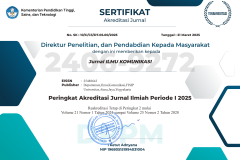Representasi Ciuman Romantis-Seksual dalam Film Ada Apa dengan Cinta?
DOI:
https://doi.org/10.24002/jik.v16i1.1313Keywords:
Representation, Semiotics, Film, Romantic-Sexual KissingAbstract
This study aims to identify and analyze representations of romantic-sexual kissing in Indonesian fiction films, those are Ada Apa dengan Cinta? (2001) and Ada Apa dengan Cinta? 2 (2016). This study uses the kissing concept of Linda Williams (2008) which links the presence of kisses to the terminology of romanticism and sexuality and Willem Frijhoff’s (2014) shape and type of kissing that influence the meaning of kisses. The kissing scenes in both films was identified by Roland Barthes’s semiotics method. The results of the study indicate that those two films contain romantic-sexual kissing that further strengthens romantic and sexual ideologies.
References
Barthes, Roland. (1972). Mythologies (Selected and translated from French by Annette Lavers). New York Farrar, Straus & Giroux: The noonday Press.
Benson, Walter. (1901). The Kiss and Its History. Provo. Utah: Oliver & Boyd Edinburgh.
Berger, Arthur Asa. (2000). Media Analysis Techniques: Teknik-teknik Analisis Media. Alih bahasa oleh Setio Budi HH. Yogyakarta: UAJY.
Danesi, Marcel. (2013). The History of Kiss!: The Birth of Popular Culture. New York: Palgrave Macmillan.
Film Indonesia. (2016, Oktober 1). Data Penonton. <http://filmindonesia.or.id/movie/viewer/2016#.Wd9T4H2CzIU>, <http://filmindonesia.or.id/movie/review/rev4cd636ea84c34_ada-apa-dengan-cinta#.WIi-HtJ97IU>
Frijhoff, Willem. (2014). The kiss sacred and profane: reflection on a cross-cultural confrontation.<https://www.researchgate.net/publication/254822406>
Hall, Stuart. (1997). Representation: Cultural Representations and signifying Practices. London: SAGE Publication.
Jankowiak, William R., Volsche, Shelly L. & Garcia, Justin R. (2015). “Research Report: Is the Romantic – Sexual Kiss a Near Human Universal?” . American Anthropologist, 117(3), 535-539.
K.Opler, Marvin. (1969). “Cross-Cultural Aspects of Kissing”. Medieval Aspect of Human Sexuality, 3(2), 11,13,17, 20-21.
Komisi Penyiaran Indonesia. (2004). Pedoman Perilaku Penyiaran dan Standar Program Siaran. Jakarta.
______________________. (2012). Pedoman Perilaku Penyiaran (p3) dan Standar Program Siaran (SPS). Jakarta.
Lewis, Jon. (2002). Hollywood v. Hard Core: How the Struggle Over Cencorship Saved the Modern Film Industry. New York and London: New York University Press.
Peraturan Pemerintah Republik Indonesia. (1994). Tentang Lembaga Sensor Film Presiden Republik Indonesia. Menteri Negara Sekretaris Negara Republik Indonesia. Jakarta.
Prastista, Himawan. (2008). Memahami Film. Cetakan kedua. Yogyakarta: Homerian Pustaka.
Rudman, Laurie A. & Glick, Peter. (2008). The social Psychology of Gender: How Power and Intimacy Shape gender Relations. New York: The Guilford Press.
Samuel, Raymond. (2013). Ketika “Ciuman Massal” Jadi Senjata Protes.
Slama, Martin. (2013). Transformasi Keintiman di Indonesia? Sebuah Kajian Awal tentang Ciuman.<http://interseksi.org/archive/publications/essays/articles/transformasi_keintiman.html>
Solomon, Robert. (2002). “Sexual Paradigm”. Dalam Soble, Alan (ed.),The Philosophy of Sex: Contemporary Readings (4th ed) (h. 21-30). New York: Rowman & Littlefield Publisher, INC.
Todd, Erica. (2014). Passionate Love and Popular Cinema: Romance and Film Genre. New York: Palgrave Macmillan.
Walter, Chip. (2008). Affairs of the Lips: Why We Kiss. Scientific American Mind. <http://www.scientificamerican.com/article.cfm?id=affairs-of-the-lips-why-we-kiss&print-true>
Williams, Linda. (2006). “Of Kisses and Ellipses: The Long Adolescence of American Movies”. Critical Inquiry,32 (2), 288-340.
Downloads
Published
How to Cite
Issue
Section
License
Jurnal ILMU KOMUNIKASI is an academic journal. As such, it is dedicated to the open exchange of information. For this reason, JIK is freely available to individuals and institutions. Authors who publish in Jurnal ILMU KOMUNIKASI will release their articles under the Creative Commons Attribution (BY) License. This license allows anyone to copy and redistribute the article in any medium or format as well as remix, transform, and build upon the material for any purpose, even commercially as long as they credit the authors for the original creation. For details of the rights authors grants users of their work, see the "human-readable summary" of the license, with a link to the full license. (Note that "you" refers to a user, not an author, in the summary)
 This work is licensed under a Creative Commons Attribution 4.0 International License.
This work is licensed under a Creative Commons Attribution 4.0 International License.














